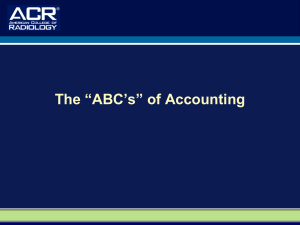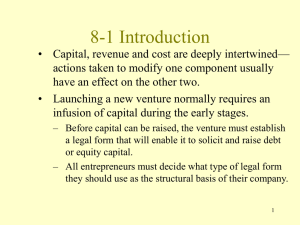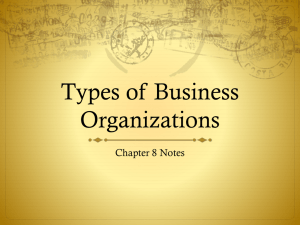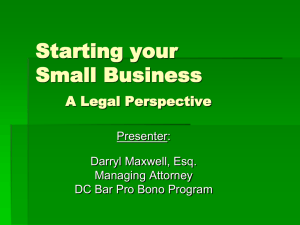SP, GP, LLC, LLP, C Corp, S Corp: Decoding the Alphabet Soup of
advertisement
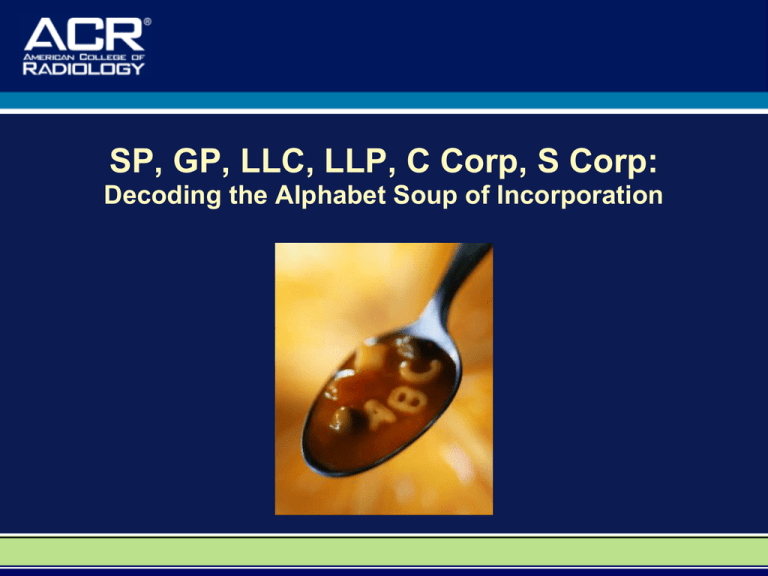
SP, GP, LLC, LLP, C Corp, S Corp: Decoding the Alphabet Soup of Incorporation A Special Thank You to: Dr. David M. Yousem, M.D., M.B.A. Professor, Department of Radiology Vice Chairman of Program Development Director of Neuroradiology Johns Hopkins Hospital for allowing the use of his material/content in this presentation Dr. Yousem’s online lecture series can be viewed at: http://webcast.jhu.edu/mediasite/Catalog/pages/catalog.aspx?catalogId=7e 18b7d5-9c63-487e-aaf1-77a86f83b011 Dr. Yousem’s project was funded through an RSNA Educational Grant Why should I care? • Protection of personal assets o Limiting liability • Possible taxation benefits • Selling stock to raise funds • Durability o Corporation continues indefinitely • Transfer of ownership • Corporation has its own credit and credit rating Types of Businesses • • • • Sole proprietorship General Partnership Limited Liability Partnership, LLP Corporation o o C Corporation S Corporation • Limited Liability Company, LLC o Professional Limited Liability Company, PLLC • Pass-through entity Sole Proprietorship • • • • Single owner No legal distinction between the person and the business All assets owned by the person All profits pass to the owner – taxes paid on owners personal tax return • Unlimited personal liability • No durability o Example: After the death of the owner the business ceases to exist General Partnership • Association of 2 or more persons • Generally created by partnership agreement o In the US a partnership is legally recognized as a separate entity from the persons making it up • No protection from personal liability o Owners are personally liable for all debts, taxes, and liabilities of the business • Profits shared between partners as specified in the partnership agreement – taxes are paid on each partners tax return • Decision making powers are specified in the partnership agreement • No durability o Technically a partnership dissolves after death of a member Limited Partnership, LP • One or more General Partners o Run the business, have decision making authority o Personally liable for all debts, taxes, malpractice • One or more Limited Partners o Limited partners generally do not get involved with day to day decisions o No personal liability, only liable up to their investment Example: Jane (general partner) owns a building and Joe (limited partner) invests money with Jane. Jane shares the buildings profits with Joe. If the building burns down Joe would only lose his investment and would not be liable for additional damages. Limited Liability Partnership, LLP • All partners have limited liability • You are not personally liable for debts and taxes of the business • You are not responsible for your partners negligence or malpractice • You are responsible for your own negligence or malpractice • Different from a corporation by the fact that all partners retain decision making capacity • Typically used by lawyers, accountants and architects C-Corporation • Separate legal entity, created to maximize profit and limit liability • Profits are double taxed • The corporation is taxed on its income • The dividends it pays to its shareholders are also taxed • Limited corporate liability • Shareholders only lose their investment if the corporation fails • Personal liability • Malpractice is not covered by corporate liability • Small portions of the company owned by shareholders (i.e. stock) • No limit to number of shareholders • The may different types of stock (preferred stock) • Additional information • IRS Publication 542 S-Corporation • Separate legal entity from its shareholders • Annual state tax/fee for existence • Not double taxed • Corporate income is divided among the shareholders • Individual shareholders must declare income on their individual taxes • Limited liability same as a C-Corporation • Different shareholder structure from a C-Corporation • Only one type of share (no common or preferred stock) • Limited to 100 shareholders or less • Shareholders must be U.S. Citizens or residents • Profits are allocated to shareholders based on their investment in the business • Additional information • IRS Publication 542 How is a corporation formed • C-Corporation • • • • • • Name is chosen Initial board of directors appointed File paperwork Create bylaws First board of directors meeting Issue stock • S-Corporation • Same as for C-Corporation, but must meet special requirements as outlined in the previous slide • Conversion from a C-Corporation to an S-Corporation must be by unanimous shareholder vote • If an S-Corporation fails to fulfill the special requirements of an SCorporation it will automatically revert to a C-Corp and be taxed as such Limited Liability Company, LLC • Blend of aspects of a partnership (or sole proprietorship if there is a single owner) and a corporation • A LLC is not considered a corporation • Limited liability • Only members’ investments are at risk • Taxation by default is similar to a sole proprietorship or general partnership • A LLC can elect to be taxed as a C-Corp or S-Corp • Some states allow formation of PLLC (professional limited liability company) for professions that require a license to operate (such as doctors or lawyers) A few words about limited liability • Financial liability for the companies debts is limited to a fixed sum • Most commonly the sum of the person’s investments, you can’t lose more money than you have invested • If a plaintiff sues a corporation they are suing the corporation and not an individual • You are still liable for your own actions • Limited liability does not protect you from malpractice • It does protect you from your partners malpractice (in the case of a LP or LLP) or other shareholders malpractice (in the case of a corporation) Pass-Through Entity • Aims to avoid double taxation • The entity files tax returns, but does not actually pay taxes • Only the investors are taxed • Form K-I is issued to each investor reporting their individual earnings/ losses In a nutshell • Limited liability • LP, LLP, LLC, and incorporation all provide their partners and shareholders with limited liability protection • Sole proprietorships and general partnerships do not provide this protection • In any of these business types you are still liable for your own actions/malpractice • Taxation • C-Corporations are “double taxed” • They pay tax on corporate income • Their shareholders pay tax on the dividends • The remainder of the business types are “pass through” which means the profits are taxed based on the individual’s tax return In a nutshell (continued) • Decision making capacity • In a partnership all partners are part of decision making process • In a corporation the board of directors holds the decision making power • Paperwork • C-corporations and S-corporations require the most paperwork to initially set up the business and to keep it going • i.e. usually requires an accountant and perhaps a lawyer • LPs and LLPs • Less paperwork • Technically sole proprietorships and general partnerships do not require the filing of any paperwork with the federal or state government In a nutshell (continued) • Additional information • Partnerships need to be made up of at least two people • S-corporations • No more than 100 shareholders, all US citizens or residents • Only 1 type of stock • C-corporations • Unlimited shareholders, multiple classes of stock References • • • “Business of Radiology”. Lecture series by Dr. David Yousem. http://tinyurl.com/yousem-biz. Accessed December 2010 “LLCs, corporations, partnerships, etc.” www.nolo.com Accessed December 2010 “Publication 542" (PDF). Department of the Treasury, Internal Revenue Service. February 2006. http://www.irs.gov/pub/irs-pdf/p542.pdf. Retrieved December 2010.


